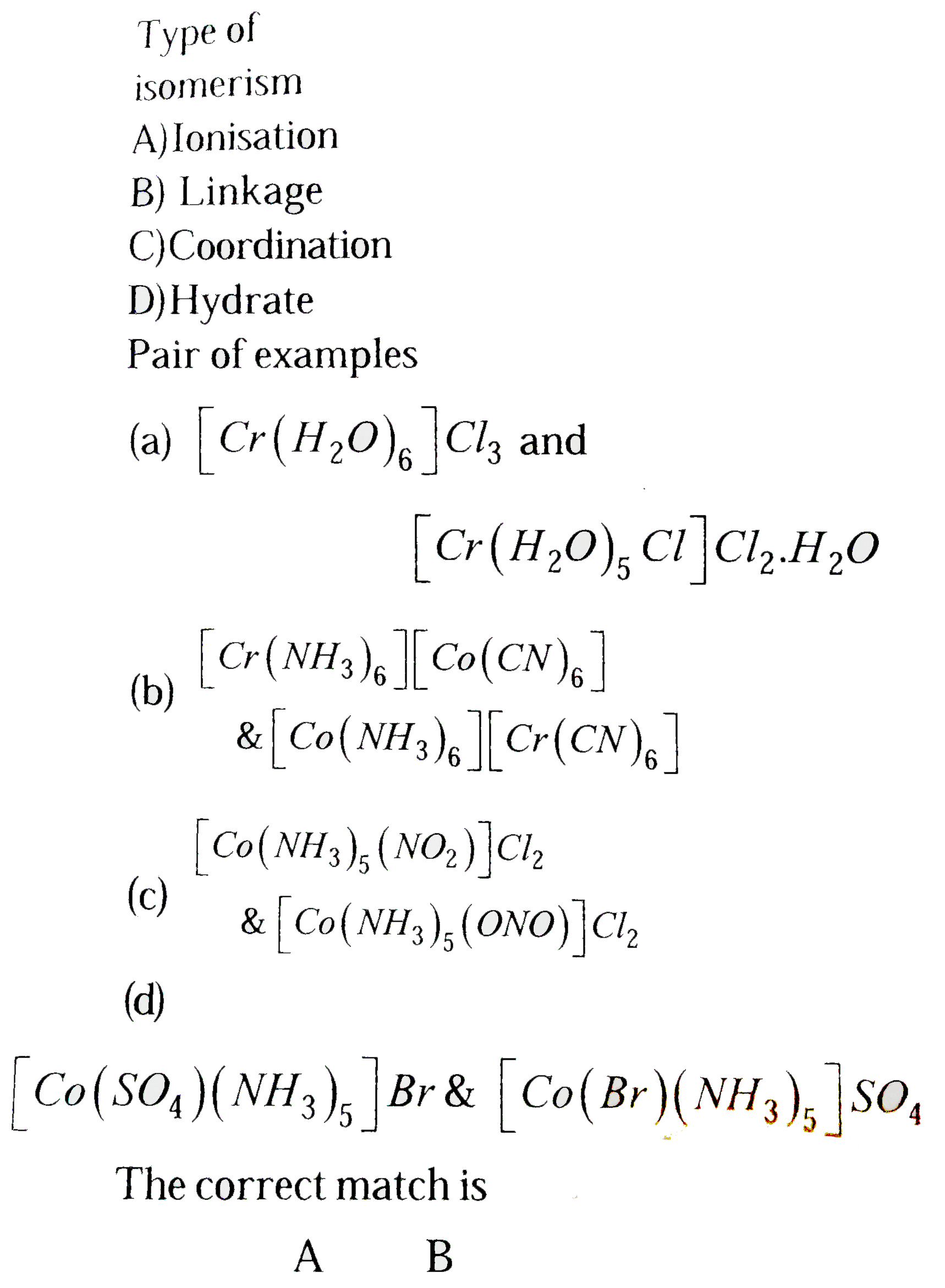Which types of isomerism is shown by 2,3-dichlorobutane
Distereo
Optical
Geometric
Structural
The correct Answer is:B
To determine the types of isomerism shown by 2,3-dichlorobutane, we can follow these steps:
Step 1: Identify the Structure
2,3-dichlorobutane has the following structure:
- It is a four-carbon chain (butane) with chlorine atoms attached to the second and third carbon atoms.
Step 2: Determine Chiral Centers
- In 2,3-dichlorobutane, both the second and third carbon atoms are chiral centers because they each have four different groups attached to them:
- C2: CH3, H, Cl, and the rest of the carbon chain.
- C3: CH3, H, Cl, and the rest of the carbon chain.
Step 3: Identify Types of Isomerism
- The presence of chiral centers indicates that 2,3-dichlorobutane can exhibit optical isomerism. This is because chiral compounds can exist as non-superimposable mirror images (enantiomers).
Step 4: Count the Isomers
- For a compound with two chiral centers, the maximum number of stereoisomers can be calculated using the formula 2n, where n is the number of chiral centers. Here, n=2, so:
22=4 stereoisomers
- However, one of these stereoisomers is a meso compound, which is optically inactive because it has a plane of symmetry. Therefore, the actual number of distinct stereoisomers is 3:
- 1 meso compound (optically inactive)
- 2 enantiomers (optically active)
Conclusion
- 2,3-dichlorobutane exhibits optical isomerism. There are a total of 3 stereoisomers: 1 meso compound and 2 enantiomers.
2,3-dichlorobutane has the following structure:
- It is a four-carbon chain (butane) with chlorine atoms attached to the second and third carbon atoms.
- In 2,3-dichlorobutane, both the second and third carbon atoms are chiral centers because they each have four different groups attached to them:
- C2: CH3, H, Cl, and the rest of the carbon chain.
- C3: CH3, H, Cl, and the rest of the carbon chain.
- The presence of chiral centers indicates that 2,3-dichlorobutane can exhibit optical isomerism. This is because chiral compounds can exist as non-superimposable mirror images (enantiomers).
- For a compound with two chiral centers, the maximum number of stereoisomers can be calculated using the formula 2n, where n is the number of chiral centers. Here, n=2, so:
22=4 stereoisomers
- However, one of these stereoisomers is a meso compound, which is optically inactive because it has a plane of symmetry. Therefore, the actual number of distinct stereoisomers is 3:
- 1 meso compound (optically inactive)
- 2 enantiomers (optically active)
- 2,3-dichlorobutane exhibits optical isomerism. There are a total of 3 stereoisomers: 1 meso compound and 2 enantiomers.
Topper's Solved these Questions
- GENERAL ORGANIC CHEMISTRYBOOK - ERRORLESS CHAPTER - GENERAL ORGANIC CHEMISTRYEXERCISE - Classification and nomenclature of organic compounds
117 Videos
- GENERAL ORGANIC CHEMISTRYBOOK - ERRORLESS CHAPTER - GENERAL ORGANIC CHEMISTRYEXERCISE - Critical Thinking (Objective Questions)
44 Videos
- GENERAL ORGANIC CHEMISTRYBOOK - ERRORLESS CHAPTER - GENERAL ORGANIC CHEMISTRYEXERCISE - Organic reactions and their mechanism
67 Videos
- GASEOUS STATE BOOK - ERRORLESS CHAPTER - GASEOUS STATE EXERCISE - JEE SECTION JEE (Advanced) 2018 Numeric answer type question
1 Videos
- HALOGEN CONTAINING COMPOUNDBOOK - ERRORLESS CHAPTER - HALOGEN CONTAINING COMPOUNDEXERCISE - Critical Thinking (Jee (Advanced) 2018)
1 Videos
Similar Questions
Knowledge Check
Which type of isomerism is shown by 2, 3-Dichlorobutane ?
ADiastereoBOpticalCGeometricDStructureWhich type of isomerism is shown by 2,3-dichlorobutane?
ADiasteroBGeometricalCOpticalDStrucutralWhich type of isomerism is shown by 2, 3-Dichlorobutane ?
ATautomerismBOpticalCGeometricalDFunctional isomerism
Which type of isomerism is shown by pentaone?
View SolutionWhich type of isomerism is shown by diethyl ether and methyl propyl ether
View SolutionWhich type of isomerism is shown by diethyl ether and methyl propyl ether?
View SolutionWhich type of isomerism is shown by 1,2 - dimethylcyclopropane ?
View Solution
Shows which type of isomerism
View Solution

